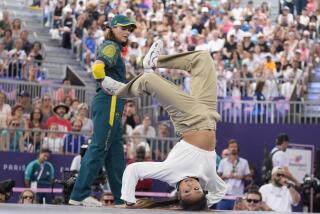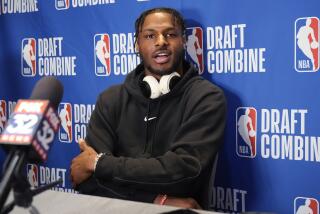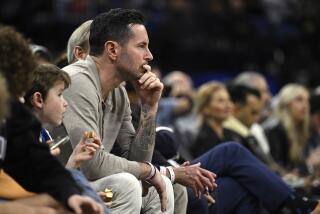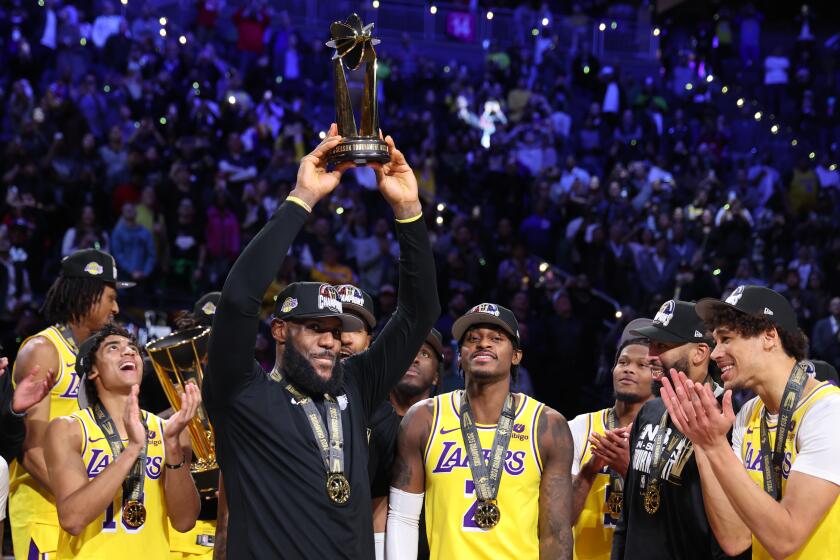Gone but not forgotten: Andrew Bynum’s top moments with Lakers
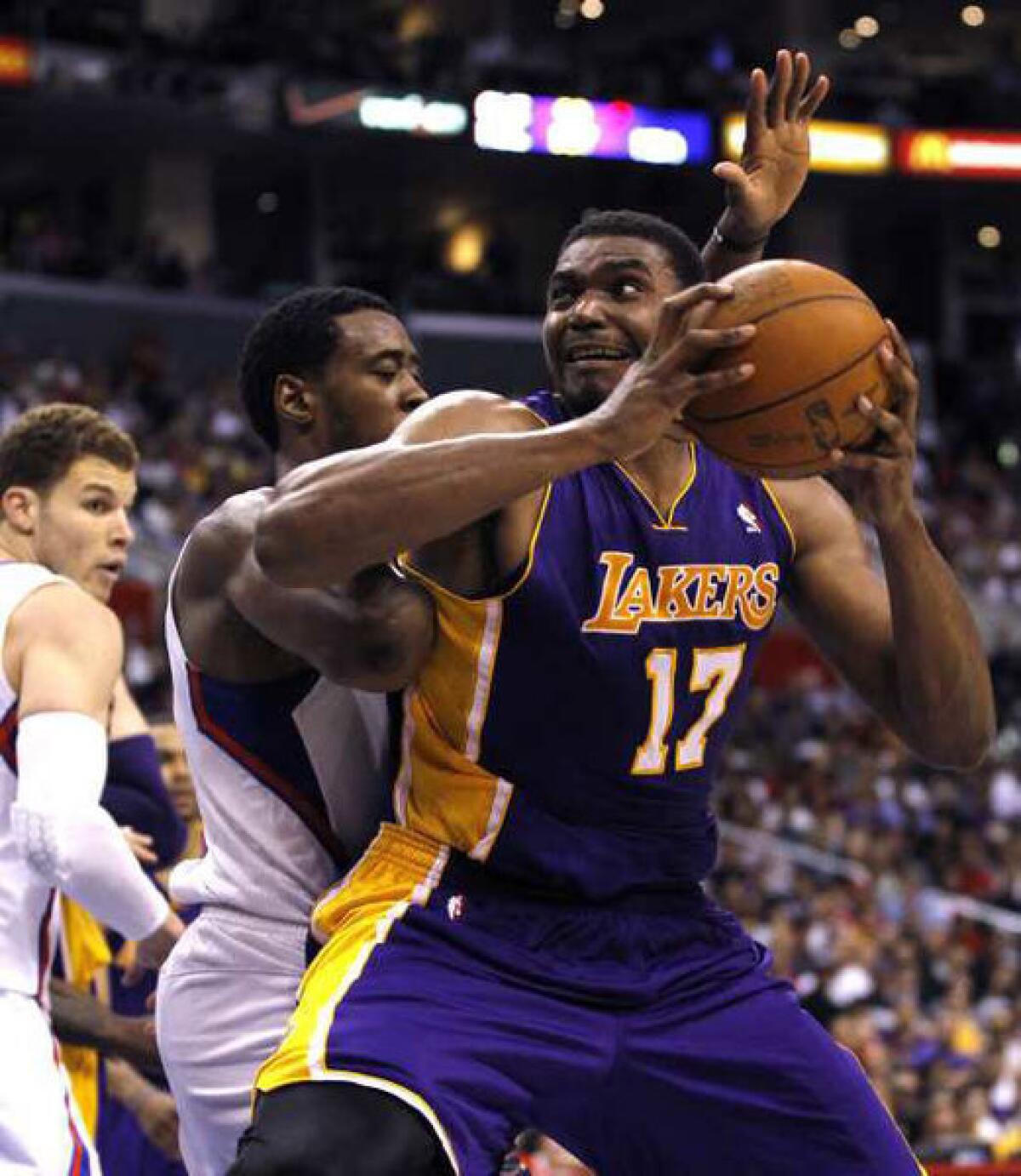
Let’s make one thing clear. Even if Andrew Bynum’s immaturity and inconsistent effort severely hurt the Lakers last season, they traded him to the Philadelphia 76ers in a four-team, 12-player deal that landed them Dwight Howard for one reason only.
“We got the best,” Lakers General Manager Mitch Kupchak said.
Perhaps Kupchak was providing a good poker face when he professed not having any concern about Bynum’s behavior. Maybe Kupchak actually meant what he said. Regardless, the Lakers would’ve traded Bynum for Howard if the opportunity presented itself. Still, through all his head-scratching behavior, ill-timed quotes and extensive injury history, Bynum grew tremendously as a player during his seven-year career with the Lakers. Here are his top five moments.
1. Bynum had a breakout season in 2011-12. When Bynum felt like it, he showed very little could stop him from absolutely dominating. He posted career highs in points (18.7), rebounds (11.4) and minutes (35.2). Within a handful of games, Kobe Bryant already proclaimed that Bynum had climbed up the pecking order ahead of Pau Gasol. He made his first All-Star appearance, and he became the fifth Laker in history to record 30 rebounds in a game, joining Wilt Chamberlain, Kareem Abdul-Jabbar, Elgin Baylor and Shaquille O’Neal. Bynum’s triple-double performance in Game 1 of the Lakers’ first-round series against Denver featured him setting a Lakers record and tying an NBA playoff record for most blocks in a postseason game (10). Finally, Bynum went through a season without a major injury.
All this happened because Bynum showed marked improvement on developing his game in nearly every facet. His off-season boxing lessons helped his footwork. Throughout the season, Bynum showed more awareness on noticing and reacting off double teams. He intimidated players who thought about driving into the lane.
Of course, this just increased frustration among the Lakers and their fans when he tarnished his effort with bouts of immaturity. He was benched for taking an ill-advised three-pointer, then said he’d shoot more. Bynum earned two ejections within a two-week span. He skipped a meeting with Kupchak and often ignored Brown’s coaching and team huddles. Bynum repeatedly violated team rules by blasting music in the locker room. Still, the Lakers tolerated it to some degree because of what they saw he could produce when he was engaged.
2. Bynum fights through his injuries in the 2010 NBA playoffs. Usually, his knee injuries and prolonged timetables frustrated the Lakers. After all, Bynum missed an average of 31 games because of numerous injuries in the previous four seasons. This time, the injury inspired Bynum, his teammates, coaching staff, front office and fans alike. Just before the 2010 Western Conference semifinals against the Utah Jazz started, Bynum was diagnosed with a lateral meniscus tear in his right knee. Since surgery would’ve required him to miss the entire postseason, Bynum did the only thing he could to earn more respect among the organization.
He played through it. Considering how easy a time the Lakers had in dispatching Utah and Phoenix in subsequent rounds, it’s possible the Lakers could’ve absorbed Bynum sitting out. But that just toughened him up for an NBA Finals series against the Boston Celtics where the Lakers would need every ounce of his presence.
Bynum’s 7.4 points, 5.1 rebounds and 1.3 blocks in 25 minutes in that series look fairly modest. But it made a world of difference. Bynum constantly converted on offensive putbacks. He intimidated Boston from driving into the lane. When the Celtics lost Kendrick Perkins late in Game 6 to injury, Bynum’s presence gave the Lakers a distinguishable size advantage. When the series was over, Bynum’s standing had grown because of his hustle and how he fought through injuries.
3. Bynum becomes a defensive force after rehabbing his knee injury. Some of that goodwill evaporated once Bynum revealed he’d miss the first 24 games of the 2010-11 season because he still needed to rehab. It became a point of contention because Bynum didn’t have surgery until July 28, partly because his doctor delayed the original appointment by 10 days and partly because Bynum wanted to attend the World Cup in South Africa.
I argued at the time Bynum’s mistake was simply tactical and didn’t reflect a lack of commitment. Regardless, he entered that season having to prove himself again. Bynum did this by largely embracing Phil Jackson’s new defensive role that entailed funneling drivers into him through the lane. Meanwhile, Bynum took a big responsibility in crashing the boards, averaging 12.3 rebounds after the all-star break. This moment of growth showed Bynum felt more empowered with a larger role even if he still didn’t receive most of the scoring touches.
4. Bynum proves Bryant wrong. Revisionist history suggests that Bryant’s profanity-laced tirade in 2007 -- when he suggested that the Lakers trade Bynum for Jason Kidd -- motivated Bynum to a show a stronger work ethic. That same framework also suggests that Pau Gasol’s arrival finally assuaged Bryant’s frustration. But these two elements were already underway. Bynum spent a good portion of the 2007 off-season working himself into better shape. He opened the 2007-08 season with some breakout stats, averaging 13.1 points, 63.6% shooting and 10.2 rebounds in 35 games. Of course, all of that enthusiasm went down the drain when he missed 46 games because of a left knee injury. But Bynum’s statistical effort was a big improvement from the 7.8 points and 5.9 rebounds he posted the previous season.
5. Bynum doesn’t back down from Shaq. Only minutes after stepping onto the floor, Bynum received a rude rookie awakening when he matched up with O’Neal. The moment took place on Jan. 16, 2006, when O’Neal leaped over Bynum and used him as a pogo stick to throw down a dunk off an offensive rebound. Bynum fell down on the floor, but he hardly let Shaq have the last word. Bynum got up. He sprinted down the court and posted up on the right block against Shaq. Bryant fed him an entry pass. Bynum then performed a spin move past Shaq for an easy dunk.
It left everyone giddy. Lakers fans at Staples Center cheered. Bynum looked pumped and nudged Shaq with his elbow afterward. Shaq looked fairly humbled, but he delivered a forearm shiver to send a message to the young Bynum. For better and for worse, this incident epitomized Bynum in a nutshell. He looked undeveloped, but he quickly overcame the learning curve. Bynum wasn’t afraid of anybody, even people of higher authority. And he gave the Lakers many glimpses of a future elite center.
ALSO:
Andrew Bynum maintains ‘I was definitely focused’ with Lakers
Email the Lakers blog at [email protected]. Follow the Lakers blog on Twitter.
More to Read
All things Lakers, all the time.
Get all the Lakers news you need in Dan Woike's weekly newsletter.
You may occasionally receive promotional content from the Los Angeles Times.
